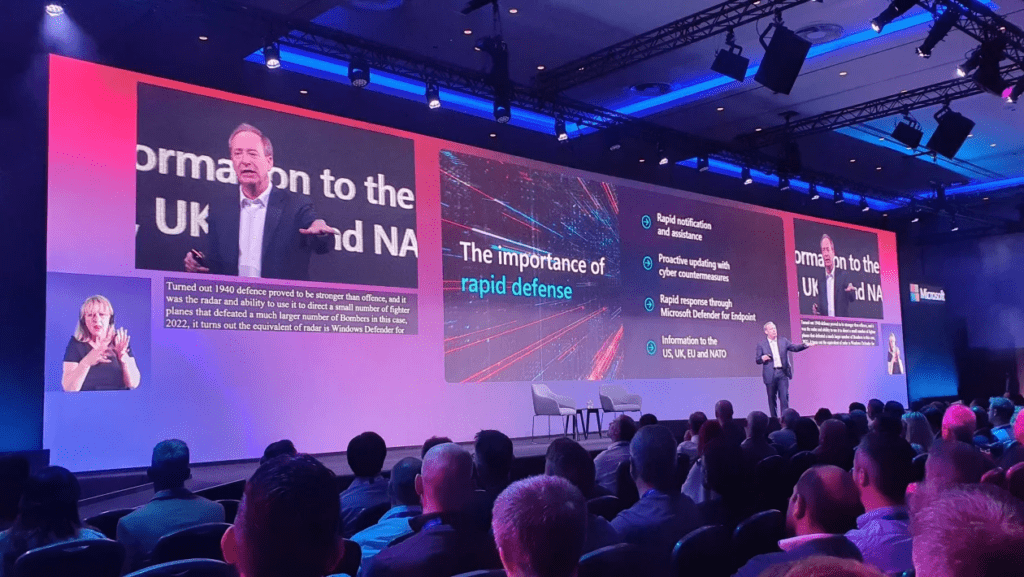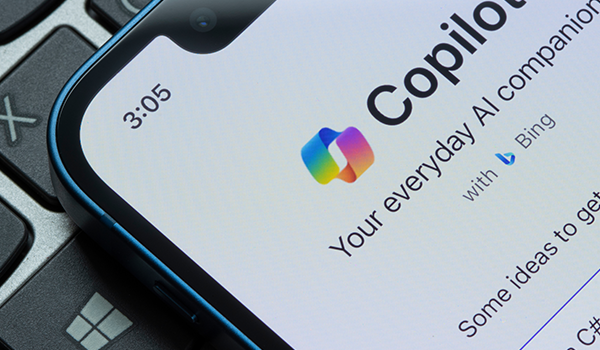Who is this blog for?
This series provides a comprehensive journey, starting with a foundational understanding of generative AI and its ethical considerations. It then bridges the gap by showcasing Copilot for Microsoft 365, a practical example of generative AI in action within your existing workflow.
The world of technology is constantly evolving, and one of the most exciting advancements is generative AI. But if you’re not familiar with the technical jargon, it can be easy to feel left behind. This blog post provides a clear explanation of generative AI, its capabilities, and its potential applications in the business world. Stay tuned for the next two blog posts in this series, where we’ll explore the ethical considerations of AI and showcase a practical example of generative AI in action.
Read time: 8 minutes
—
It’s been nearly 17 years since the world was given its first glimpse of the iPhone – in an advertisement that debuted during the 79th Academy Awards on the evening of February 25th, 2007.
No doubt a hugely significant moment in time and during a now famous keynote speech where the iPhone was introduced to the world, the late Steve Jobs explained:
“Every once in a while, a revolutionary product comes along that changes everything.”
Fast forward to October 17th, 2023, at the ExCel Exhibition Centre in London, similar statements were made about the next emerging, potentially revolutionary technology.
The event was Microsoft’s Envision, and there was a clear headline act.

This was, of course, Generative Artificial Intelligence (GAI) and, more specifically, Microsoft’s golden egg for 2024, Copilot.
During his closing words at the London-based event, Microsoft’s Chairman and CEO, Satya Nadella, described generative AI as having the potential to revolutionise the modern workplace beyond the levels set by the PC or Mobile Phone.
With the above in mind, what impact will this likely have on your life both at home and at work?
Throughout this 3-part blog series, we’ll be looking to answer these questions while exploring the journey AI has taken to date, where we are today, and what’s to come.
I’ve used Siri, Alexa, and Google Home for years, so what is generative AI?
Artificial Intelligence has been a big part of our lives for several years. In fact, the first example of artificial intelligence dates back to 1957, when American Psychologist Frank Rosenblatt introduced Perceptron, the first single-layer neural network capable of learning and making simple decisions. This algorithm paved the way for the development of neural networks and served as a foundation for the machine learning we see today.
 Fast-forward to the 21st century, following Apple’s acquisition of the Siri app in April 2010, the virtual assistant was first integrated into the iPhone 4S release in October 2011.
Fast-forward to the 21st century, following Apple’s acquisition of the Siri app in April 2010, the virtual assistant was first integrated into the iPhone 4S release in October 2011.
At the time of its release, Siri was marketed as a personal assistant that could help users perform everyday tasks using voice. Users could ask Siri to send text messages, make calls, schedule reminders, and search for information online. It also learned about the user’s interests and preferences and adapted to them over time.
Since then, Siri, as well as other similar models like Alexa and Google Home, have continued to develop and are now firmly embedded in our lives.
The above are all examples of traditional or narrow AI, where it’s programmed to deliver an action bound by specific data sets. Think of it like playing against a computer on a video game. Having been programmed in a certain way, it can use pre-defined rules to master specific strategies but not go beyond these rules to suggest new ways of playing.
While traditional AI systems are primarily used to analyse existing data sets and make predictions, GAI takes this to another level by creating new ideas and evolving from the original information.
Using a simple prompt like ‘Once upon a time, in a quiet suburb of London… ‘, Chat GPT can produce an entire story with depth and originality, complete with a protagonist, sub-characters, plot twists, and a relevant, fitting conclusion.
There is clearly a huge level of excitement, as the rate of adoption has been exponential in comparison to past revolutionary technologies. For context, Chat GPT reached 100 million users globally in just 3 months. By comparison, it took 16 years for 100 million mobile phone users to emerge, 7 years to achieve the same number of people utilising the internet, and 4.5 years for Facebook to do the same.
Naturally, adoption rates are relative to accessibility and the size of the initial audience, but impressive, nonetheless.
Just like those 100 million users, if you’d like to achieve a basic level of AI literacy then mastering prompts in ChatGPT is the most impactful starting point. Take time to learn and develop your basic understanding of generative AI models and form a solid foundation to help maximise its effectiveness on your day-to-day.
Follow this link to see the ultimate prompt guide, which will help you master your approach and see the most impactful results: ChatGPT: The Ultimate Prompt Design Guide (linkedin.com)
Follow this link to sign up to ChatGPT 3.5 for free and try it out for yourself: ChatGPT (openai.com)
What are the key factors and terms that explain how generative AI works?
Artificial Neural Networks (ANNs): Neural networks are computer systems inspired by how our brains work. Just like our brains are made up of interconnected neurons that process information, neural networks consist of interconnected artificial neurons that process data. In the case of language models, these networks are designed to process and generate text.
Machine Learning (ML): Machine learning is a computer technology that helps computers learn and make decisions from data without being explicitly programmed. It’s like teaching a computer to recognise patterns and make predictions based on examples and experience. In simple terms, it’s a way for computers to become more intelligent and capable by learning from the information they process.
Large Language Models (LLMs): LLMs are like super-smart computer programs that understand and generate human language. These models are trained on vast amounts of text from the internet, books, and other sources. They can answer questions, write original content like poetry and stories, translate languages, and complete many other language-related tasks.
So, how is generative AI being used in businesses today?
Now that we’ve covered a high-level view of how generative AI works, how it compares to traditional AI, and what you could be doing today to start adopting basic practices, let’s now explore the impact being made in businesses today.
‘AI transformation is going to follow many of the same rules of digital transformation…Many of you embarked upon your cloud journeys many years ago, and one rule really applied – that digital transformation was business transformation, empowered by technology, and in that order.’
Judson Althoff | Microsoft VP and CCO
The above quote, taken from the Microsoft Envision event, explains how this should not be implemented purely as technology for technology’s sake but rather to achieve tangible, measurable business outcomes.
 So, while there are already several use cases, here are five common and impactful real-world examples.
So, while there are already several use cases, here are five common and impactful real-world examples.
Content Generation: Generative AI models generate human-like text, which can be employed in content creation, chatbots, and virtual assistants for answering customer queries, drafting reports, and creating marketing materials.
Natural Language Processing: Businesses utilise NLP models to analyse customer feedback and social media data, enabling sentiment analysis to gauge customer opinions and drive relevant improvements. Equally, NLP models can be used for real-time translation services, improving interactions with international customers and vendors.
Chatbots and Virtual Assistants: Generative AI powers chatbots and virtual assistants for efficient customer support, addressing common customer queries and providing out-of-hours assistance.
Fraud Detection: Generative models can help identify unusual patterns in transaction data, assisting in the early detection of fraudulent activities.
Text summarisation: Generative models can summarise long documents or articles, making it easier for businesses to digest and understand complex information.
Are there any industry-specific use cases or considerations?
As mentioned by Satya Nadella at the Envision event, while there are, of course, industry-specific use cases, the success and effectiveness of generative AI will be “by firm, not by industry.” This means that businesses across all industries can recognise opportunities to embed generative AI into their operational processes and see tangible improvements, but only relative to the level of time and resources invested in preparing their organisation.

As a result of such investment, there are already truly transformative examples from some key industries.
Healthcare:
- Medical Imaging: Generative AI is used to enhance and reconstruct medical images, making them more transparent and informative.
- Drug Discovery: AI models generate molecular structures, predict potential drug candidates, and assist in drug development.
Finance:
- Fraud Detection: Generative AI helps identify unusual patterns in financial transactions and detect potentially fraudulent activities.
- Algorithmic Trading: AI models can generate trading signals, optimise trading strategies, and predict market trends.
Retail:
- Inventory Management: AI can generate demand forecasts and optimise inventory levels, reducing stock issues.
- Visual Search: Generative AI powers visual search engines, allowing customers to search for products using images.
Manufacturing:
- Quality Control: AI models can generate inspection criteria and assist in quality control processes, helping to identify defects and ensure product quality.
- Predictive Maintenance: Generative AI generates predictive maintenance schedules based on historical data, minimising downtime and maintenance costs.
Legal:
- Contract Analysis: AI models assist in summarising and analysing legal documents and contracts, making legal research more efficient.
- Document Generation: AI can generate legal documents, such as wills and contracts, based on user input.
It’s important to reference that adoption levels across specific industries, especially those that are heavily regulated, will naturally take longer. As we’ll explore in the other instalments of this series, due to the potential data and security-related risks, it’s imperative a suitable ‘code of conduct‘ is formulated.
Where does Copilot fit into this and what will the rest of the blog series explore?
Microsoft Copilot is simply the next significant step to seeing generative AI as an ever-present across our personal and working lives. According to Microsoft’s definition, Copilot “works alongside popular Microsoft 365 Apps such as Word, Excel, PowerPoint, Outlook, Teams, and more, while providing real-time intelligent assistance, enabling users to enhance their creativity, productivity, and skills“.
Crucially, this is a copilot, not an autopilot. While Microsoft’s ambition is for Copilot to become ubiquitous throughout your Microsoft environment, its purpose is to enable and empower users, not to replace them or make decisions on their behalf.
Later in this blog series, we’ll explore Microsoft Copilot in more depth, touching upon its purpose, the opportunity, the risks and what you can do next to kick-start your journey.
Before we do so, the next instalment will touch on the potential dangers and how we can overcome our fear of the unknown, to embrace AI in the safest and most positive way. We’ll also explain the premise of adopting a responsible AI framework, ensuring a foundation of fundamental ethical principles is adhered to.






